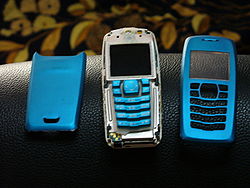- Nokia 3100
-
Nokia 3100 
Manufacturer Nokia Carriers AT&T Wireless/Cingular Compatible networks 3100:
 GSM 900/1800/1900
GSM 900/1800/1900
3100b:
 GSM 850/1800/1900
GSM 850/1800/1900
3105:
CDMA2000 1xRTTSuccessor Nokia 3200 Form factor Candybar Dimensions 102 x 43 x 15.2 mm Weight 99 g Operating system Series 40 Memory 350 KiB Battery BL-5C, 850 mA·h Display 128x128 4096 color CSTN Rear camera 640x480 VGA
(sold separately, added via Pop-Port)Connectivity None The Nokia 3100 is a triband-GSM cellphone released on the 17th of June 2003 as an entry-level phone from Nokia, designed primarily for the younger market.
The Nokia 3100 was developed from the Nokia 6100 as a successor to the Nokia 3510i.
The phone is equipped with a 128x128 pixel passive colour display (4096 colors/12-bit), Java MIDP 1.0, XHTML and WAP browser, GPRS, Pop-Port connectivity and Lithium-ion battery. It is also capable of playing polyphonic MIDI files, which can be used as ringtones.
Contents
Menu system
The Nokia 3100 uses Nokia's Series 40 platform firmware that uses large static icons rather than animated icons that are used on some of the other Nokia phones.
The menu has 14 main categories:
- Messages - This consists of a multimedia and text messages editor
- Call register - It records the duration of calls and connections and used phone numbers
- Phone book - A phone book with contacts editor
- Profiles - User profiles for various situations (silent, loud, general, etc.)
- Settings - All phone settings are stored here
- Alarm clock - A simple alarm clock
- Gallery - Small file manager in which you can store images and ringtones
- Calendar - Calendar with notes and reminders
- Games - Directory for Java games
- Applications - Directory for applications
- Extras - Some extra tools like calculator, countdown timer and stopwatch
- Services - WAP browser and WAP settings
- Go to - settings for "Go to" menu, all most used functions are stored here as shortcuts
- SIM Application Toolkit menu - this contains information stored in SIM card such as network bonus services or pay services (appears only if the used SIM card offers these services)
The phone can send and receive text and multimedia messages with ringtones and images in BMP, JPEG, PNG and GIF formats. The basic 3100 does not have any voice recorder, radio receiver, MP3 player or camera, while the 3100b version supports voice recording. A camera can be added to the phone via its Pop-Port.
This was one of the most popular Nokia phones in Europe and United States.[citation needed]
In 2004 Nokia released the Nokia 3120 phone, which is different from the 3100 in having a new metallic effect covers and a revised keypad.
The Nokia 3200 builds on the features of the Nokia 3100, and incorporates more features from the Nokia 7250i, such as a built-in CIF-resolution camera.
Variants
Nokia 3100 (RH-19)
The basic version, intended to be used in European GSM networks. It works in GSM 900/1800/1900.
Nokia 3100b (RH-50)
This version intended to be used in American GSM networks. It works in GSM 850/1800/1900.
Differences from the basic 3100:
- Additional main menu interface is present, referred to as Grid in phone's settings menu (the original interface is referred to as Line)
- TTY/TTD option in Menu → Settings → Enhancement settings; note that this menu appears only if the phone has been connected to some enhancement device (as referred to by Nokia), for example, to a headset or a TTD
- Voice recording feature, allowing to record 1 min long pieces of speech, sound or an active call
- World Clock application included
Nokia 3105
The CDMA version of the Nokia 3100, working in CDMA2000 1xRTT networks. It is physically similar to the 3100 except for a built-in flashlight and a slightly different shape of the rear battery cover; the phone's firmware is more feature-rich than the basic 3100 or 3100b (e.g.: voice tags and voice commands, Organizer menu, etc.)
The Nokia 3105 was used in Australia on the Hutchison Orange network until the closure of the CDMA network in Australia in late 2006. All customers on the Orange network were then moved to Hutchison's 3G network "3".
External links
Nokia mobile phones Nokia 1000 series 
Nokia 2000 series Nokia 3000 series Nokia 5000 series Nokia 6000 series - 6010
- 6020/6021
- 6030
- 6070
- 6085
- 6100
- 6101
- 6103
- 6110/6120
- 6110 Navigator
- 6111
- 6120/6121/6124 classic
- 6131/6133
- 6136
- 6151
- 6170
- 6210
- 6210 Navigator
- 6220 classic
- 6230
- 6230i
- 6233/6234
- 6255i
- 6260 Slide
- 6265
- 6270
- 6275i
- 6280/6288
- 6290
- 6300
- 6300i
- 6301
- 6303 classic
- 6310i
- 6315i
- 6500 classic
- 6500 slide
- 6510
- 6555
- 6600
- 6600 fold
- 6600 slide
- 6610i
- 6620
- 6630
- 6650
- 6650 fold
- 6670
- 6680
- 6681/6682
- 6700 classic
- 6700 slide
- 6710 Navigator
- 6720 classic
- 6730
- 6760 Slide
- 6800
- 6810
- 6820
- 6822
Nokia 7000 series Nokia 8000 series Nokia 9000 series
(Nokia Communicator)Nokia 000series Nokia Asha - Asha 200/201
- Asha 300
- Asha 303
Nokia Cseries Nokia Eseries Nokia Nseries Nokia Xseries Nokia Lumia Nokia Internet Tablet N-Gage Others Concept Categories:- Nokia mobile phones
Wikimedia Foundation. 2010.
